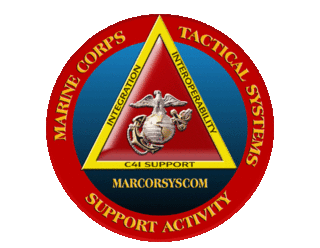
The United States Strategic Command (USSTRATCOM) is one of the eleven unified combatant commands in the United States Department of Defense. Headquartered at Offutt Air Force Base, Nebraska, USSTRATCOM is responsible for strategic nuclear deterrence, global strike, and operating the Defense Department's Global Information Grid. It also provides a host of capabilities to support the other combatant commands, including integrated missile defense; and global command, control, communications, computers, intelligence, surveillance, and reconnaissance (C4ISR). This command exists to give "national leadership a unified resource for greater understanding of specific threats around the world and the means to respond to those threats rapidly".

The Combat Capabilities Development Command (CCDC) C5ISR Center, formerly the Communications-Electronics RD&E Center (CERDEC), is the United States Army information technologies and integrated systems center. CCDC C5ISR Center is headquartered at Aberdeen Proving Ground in Maryland, with activities at Fort Belvoir in Virginia and Joint Base McGuire-Dix-Lakehurst in New Jersey.
The U.S. Navy Electronics Laboratory (NEL) was created in 1945, with consolidation of the naval radio station, radar operators training school, and radio security activity of the Navy Radio and Sound Lab (NRSL) and its wartime partner, the University of California Division of War Research. NEL’s charter was “to effectuate the solution of any problem in the field of electronics, in connection with the design, procurement, testing, installation and maintenance of electronic equipment for the U.S. Navy.” Its radio communications and sonar work was augmented with basic research in the propagation of electromagnetic energy in the atmosphere and of sound in the ocean.

The Naval Air Systems Command (NAVAIR) provides materiel support for aircraft and airborne weapon systems for the United States Navy. It is one of the Echelon II Navy systems commands (SYSCOM), and was established in 1966 as the successor to the Navy's Bureau of Naval Weapons.
Net-centric Enterprised Solutions for Interoperability (NESI) is a joint effort between the United States Navy’s Program Executive Office for C4I & Space and the United States Air Force’s Electronic Systems Center. It provides implementation guidance which facilitates the design, development, maintenance, evolution, and use of information systems for the Net-Centric Operations and Warfare (NCOW) environment. NESI has also been provided to other Department of Defense (DoD) services and agencies for potential adoption.

The Naval Information Warfare Center Pacific, formerly the Space and Naval Warfare Systems Center Pacific, the Naval Command, Control and Ocean Surveillance Center (NCCOSC) RDT&E Division, the Space and Naval Warfare Systems Center San Diego, and the Naval Ocean Systems Center (NOSC), provides the U.S. Navy with research, development, delivery and support of integrated command, control, communications, computers, intelligence, surveillance and reconnaissance (C4ISR), cyber and space systems and capabilities across all warfighting domains. The only Naval technical center headquartered in a major fleet concentration area, NIWC Pacific manages strategic locations both in the Pacific theater and around the world.

Command and control is a "set of organizational and technical attributes and processes ... [that] employs human, physical, and information resources to solve problems and accomplish missions" to achieve the goals of an organization or enterprise, according to a 2015 definition by military scientists Marius Vassiliou, David S. Alberts, and Jonathan R. Agre. The term often refers to a military system.
A program executive officer, or PEO, is one of a few key individuals in the United States military acquisition process. As can be seen from the examples below, a program executive officer may be responsible for a specific program, or for an entire portfolio of similar programs.

The Marine Corps Tactical Systems Support Activity (MCTSSA) is the Marine Air-Ground Task Force (MAGTF) Command, Control, Communication, Computer, Intelligence (C4I) Integration center for the United States Marine Corps. They are a component of Marine Corps Systems Command (MARCORSYSCOM) and are located at Marine Corps Base Camp Pendleton, California

The Naval Information Warfare Center Atlantic is an Echelon III activity of the United States Navy located in North Charleston, South Carolina. The center’s mission is to deliver information warfare solutions that protect national security. This includes communication systems (radios), networking systems (routers/switches), cyber operations, intelligence, surveillance, reconnaissance, business systems (benefits/personnel) and information security.
The Australian Defence Organisation (ADO) is composed of the armed forces of the Commonwealth of Australia, the Australian Defence Force (ADF), and the Australian Public Service government department, the Department of Defence which is composed of a range of civilian support organisations.

The Operational Test and Evaluation Force (OPTEVFOR) is an independent and objective agency within the United States Navy for the operational testing and evaluation (OT&E) of naval aviation, surface warfare, submarine warfare, C4I, cryptologic, and space systems in support Navy and Department of Defense acquisition programs.

The Communications-Electronics Command (CECOM) is a Life Cycle Management Command (LCMC) of the United States Army based at Aberdeen Proving Ground, Maryland, United States. It is one of four such commands under the Army Materiel Command (AMC), and is the Army's provider and maintainer of Command, Control, Communications, Computers, Cyber, Intelligence, Surveillance and Reconnaissance (C5ISR) capabilities.
The Deputy Assistant Secretary of the Navy for C4I and Space Programs is a civilian office of the United States Department of the Navy. The DASN (C4I/Space) reports to the Assistant Secretary of the Navy for Research, Development and Acquisition, and serves as the principal adviser to the assistant secretary on issues involving command, control, communications, computers, intelligence and space programs and policy.
The systems commands, abbreviated as SysCom or SYSCOM, are the materiel agencies of the United States Department of the Navy, responsible for the design, construction, and maintenance of military systems such as ships, aircraft, facilities, and weapons. The systems commands replaced the Navy bureau system in 1966 and report to the Assistant Secretary of the Navy for Research, Development and Acquisition. The current Navy systems commands are:

The Naval Sea Systems Command (NAVSEA) is the largest of the United States Navy's five "systems commands," or materiel organizations. From a physical perspective, NAVSEA has four shipyards for shipbuilding, conversion, and repair, ten "warfare centers", the NAVSEA headquarters, located at the Washington Navy Yard, in Washington D.C., and other locations in 15 states and 3 overseas continents.

The Assistant Secretary of the Navy (Research, Development and Acquisition) (abbreviated ASN (RDA)) is a civilian office of the United States Department of the Navy. The Assistant Secretary of the Navy (Research, Development and Acquisition) requires Senate confirmation, and engages in duties as directed by the United States Secretary of the Navy.

The Naval Information Warfare Systems Command Program Executive Offices(PEOs) are organizations responsible for the prototyping, procurement, and fielding of C4ISR (Command, Control, Communications, Computers, Intelligence, Surveillance and Reconnaissance), business information technology and space systems. Their mission is to develop, acquire, field and sustain affordable and integrated state of the art equipment for the Navy.

Carl Paul Chebi is a United States Navy vice admiral who serves as the commander of Naval Air Systems Command since September 9, 2021. He most recently served as the Deputy Program Executive Officer of the F-35 Lightning II Joint Program Office from September 30, 2019 to September 9, 2021. Previously, he served as the Program Executive Officer for Command, Control, Communications, Computers, and Intelligence (C4I) and Space Systems of the Naval Information Warfare Systems Command from 2017 to 2019.














